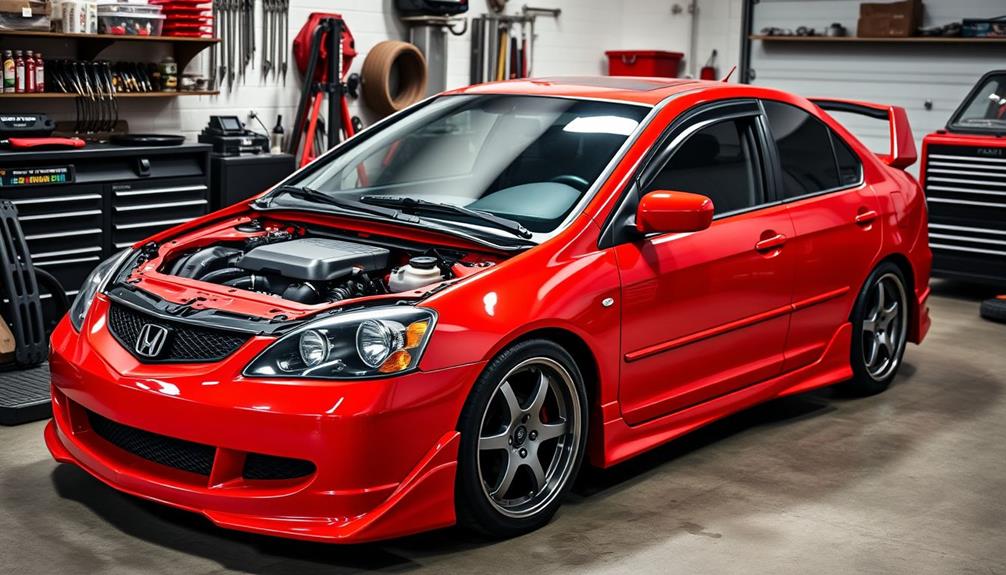Tuning your Honda Civic is a game-changer for performance. You'll start by optimizing engine parameters like fuel maps and ignition timing, potentially gaining 30 to 60 HP. Decide between forced induction or naturally aspirated setups, as both paths lead to exciting upgrades. Consider essential parts like cold air intakes, performance exhausts, and turbochargers for maximum output. Use high-octane fuel, like 93 octane, to prevent engine strain. Finally, make certain you get the right tools, like Hondata FlashPro or KTuner, for seamless tuning. As you explore these options, you'll uncover even more strategies to elevate your Civic's performance.
Key Takeaways
- Tuning a Honda Civic can increase horsepower by 30 to 60 HP through adjustments to fuel maps and ignition timing.
- Choose between forced induction for significant power gains or naturally aspirated upgrades for cost-effective enhancements.
- Essential performance parts include cold air intakes, performance exhausts, and high-performance ignition components to optimize engine output.
- Use 93 octane fuel to prevent timing retardation and maintain peak performance, while avoiding lower octane options.
- Tools like Hondata FlashPro or KTuner are vital for creating custom tunes and managing performance upgrades effectively.
Understanding Tuning Basics
Tuning your Honda Civic is one of the most effective ways to boost its performance and efficiency. When you tune, you're optimizing key engine parameters like fuel maps and ignition timing, which can lead to a horsepower increase of 30 to 60 HP.
Understanding your vehicle's financial commitments, such as budget management and savings goals, can also play a vital role in how much you can invest in performance upgrades. To achieve the best results, you should consider what type of setup your Civic has—naturally aspirated or forced induction. This choice greatly influences your tuning path based on the performance gains you're aiming for and your budget.
Utilizing tools like Hondata FlashPro or KTuner allows you to create a custom tune that fits your specific modifications and driving style, ensuring you get the most out of your engine bay.
Remember, fuel quality matters just as much; using higher octane fuels, like 93 or 100 octane, is essential for enhancing performance and efficiency, especially with performance tunes. Regular maintenance of upgraded components is also crucial, as tuning puts additional strain on the engine and related systems.
Exploring Tuning Paths

Choosing the right tuning path for your Honda Civic can greatly impact your performance outcomes and overall driving experience. You've got several options to contemplate, each tailored to your goals and budget.
| Tuning Path | Description |
|---|---|
| Path A: Forced Induction | Install a turbo kit for significant horsepower gains. |
| Path B: Naturally Aspirated | Upgrade your fuel and add a cold air intake for cost-effective enhancements. |
| Path D: Turbo Upgrades | Maximize power on 2016+ Civics with turbo upgrades. |
| Path E: Bolt-ons & Tunes | Enhance existing turbo performance with bolt-ons and ECU tunes. |
| Daily Driving Considerations | Choose parts that guarantee reliability without sacrificing comfort. |
If you opt for forced induction, you'll experience much more power, but it'll require careful maintenance. On the other hand, naturally aspirated setups can be ideal for daily driving, offering good performance without breaking the bank. Don't forget to consult with professionals or community experts to guarantee you select the best tuning path for your specific driving preferences and performance goals. This way, you'll enjoy a Civic that meets your needs and delivers an exhilarating experience on the road.
Recommended Performance Parts

When it comes to maximizing your Honda Civic's performance, selecting the right parts is crucial. Start with a cold air intake (CAI) to greatly improve airflow and boost horsepower by 5-15%. It's a popular first mod that sets the stage for further upgrades.
Additionally, integrating energy-efficient components can enhance overall performance and longevity, similar to how appliance maintenance plans extend the lifespan of home appliances.
Next, consider a performance exhaust system; a 60mm diameter works for basic setups, while a 70mm exhaust is perfect for aggressive builds. This not only enhances engine output but also gives your Civic a more aggressive sound.
If you're serious about power, upgrading to a turbocharger or supercharger kit can yield horsepower gains exceeding 100%, depending on your setup and supporting modifications.
Don't forget about high-performance ignition components—upgraded spark plugs and coils are crucial for maintaining peak performance, especially under high boost conditions.
When you add forced induction, aftermarket fuel injectors become necessary. Consider Acura RDX injectors for a cost-effective solution to increase fuel delivery.
Finally, integrating data logging tools will help you monitor your performance upgrades, ensuring that your Civic runs at its absolute best.
With these recommended performance parts, you'll be well on your way to achieving maximum performance in your Honda Civic.
Fuel Requirements and Considerations

To guarantee your Honda Civic runs at peak performance, using the right fuel is essential. The fuel you choose directly impacts engine performance and tuning effectiveness.
Additionally, maintaining proper engine health through regular check-ups can enhance performance longevity, which is vital given the potential issues related to cold medications and their effects on overall well-being.
Here are some key fuel requirements and considerations to keep in mind:
- 93 Octane Fuel: For ideal performance, especially with performance tunes, always opt for 93 octane fuel. It prevents ECU timing retardation, ensuring you get the most out of your tuning adjustments.
- Avoid 87 Octane: Using 87 octane can greatly limit your Civic's performance potential. It can lead to reduced power output and even strain on your engine, making it inadvisable for performance tunes.
- Alternative Fuel Options: Consider using 91 octane combined with 1 gallon of E85 per tank for specific tunes like the Phearable 1.5R. This combination can enhance performance and efficiency.
- Consistency Matters: Always stick to consistent fuel quality. While there's a slight cost difference of $3-5 per tank for higher octane options, the benefits to engine longevity and reliability far outweigh the expense.
Choose wisely, and your Honda Civic will reward you with electrifying performance!
Installation and Setup Tips

Setting up your tuning device is a fundamental step in maximizing your Honda Civic's performance. First, verify you have a compatible PC and download the necessary FlashPro or Ktuner software for initial setup. This is critical for effective tuning. Once you have the software installed, connect your tuning device to your computer using the provided USB cable. Follow the on-screen instructions to establish a connection with your Honda Civic’s ECU. This will allow you to make adjustments to parameters such as fuel delivery, ignition timing, and boost levels, ultimately helping to improve your Honda Civic’s performance.
In today's tech-driven world, understanding the implications of your tuning decisions is important, similar to the role of an AI Ethicist who shapes the moral framework of technology. Connect your tuner to your computer using a USB cable for device registration and warranty activation before starting the calibration process.
Once you've successfully flashed the ECU, you can unplug the tuner, but keep it handy in your glovebox for future adjustments or data logging. If you want to monitor real-time data and performance metrics, the tuner must stay connected to your vehicle.
It's important to familiarize yourself with your tuning setup, especially since OEM tunes usually support only 1-2 basic parts. For those looking to enhance their Civic's performance further, custom tuning is the best option, especially if you've upgraded to a short ram intake or other modifications.
Fine-tuning your setup can lead to much better performance. Remember, the right air and intake setup is critical for achieving your desired results and guaranteeing your Honda Civic performs at its best.
Frequently Asked Questions
How to Increase Performance on a Honda Civic?
To increase performance on your Honda Civic, consider upgrading the cold air intake, installing a performance exhaust, tuning the ECU, or adding a turbocharger. Enhancing suspension components will also improve handling and driving experience.
How to Make 300 Hp in Honda Civic?
To make 300 hp in your Honda Civic, install a turbocharger or supercharger, upgrade the exhaust, optimize with a high-performance ECU tune, and enhance airflow with a cold air intake and larger fuel injectors.
What Year of Honda Civic Is Best for Tuning?
If you're looking for the best year for tuning, consider the 2016+ Honda Civics with the 1.5T turbo engine. They provide an excellent foundation for upgrades and have great aftermarket support to enhance performance.
What Does a Tune up Consist of for a Honda Civic?
"A stitch in time saves nine." A tune-up for your Honda Civic includes replacing spark plugs, changing the air filter, checking ignition timing, inspecting the fuel system, and replacing worn ignition components for peak performance.
Conclusion
Now that you've revealed the secrets to tuning your Honda Civic, you're ready to unleash its full potential. Just like a knight outfitting their steed for battle, you'll transform your ride into a performance beast. Remember, every tweak and upgrade brings you closer to that exhilarating drive you've been dreaming of. So gear up, hit the road, and embrace the thrill of your customized Civic—it's time to make your automotive adventure legendary!










